
While the main focus of our Great Global Get-Together was the Greek Isles, we are certainly happy, no, let’s make that ecstatic, that it included a couple days in Athens. After all, how could we learn about ancient Greek culture without getting to the heart of it all?
To understand the city we had to glean the reality from the myth because, as with everywhere we went on this journey, the two are entirely intertwined.
Did the goddess Athena actually win a contest with Poseidon (the god of the sea, not the planet) that named the city? Probably not, but that story certainly contributed to Athens becoming one of the greatest cities of the ancient world.
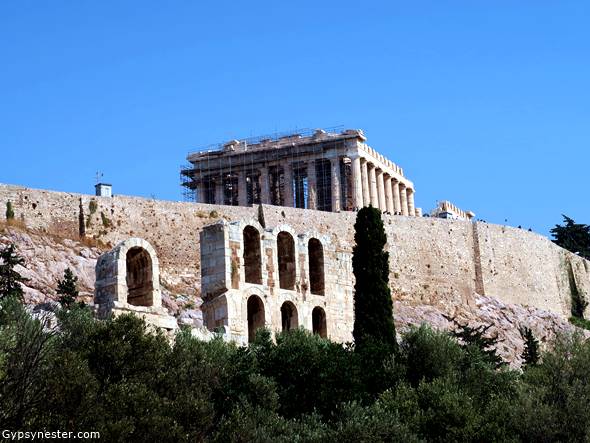 Even the competition struck us as a bit small for gods. The two were offering the city gifts and the best would become its namesake. Poseidon struck the ground with his trident and water sprung forth, however it was saltwater so… not so good.
Even the competition struck us as a bit small for gods. The two were offering the city gifts and the best would become its namesake. Poseidon struck the ground with his trident and water sprung forth, however it was saltwater so… not so good.
Athena offered the citizens the first olive tree, which is definitely better, but still seems a bit chintzy for a gift from a goddess. That certainly didn’t matter, her victory is evident everywhere, and so are olives. Maybe not such a bad gift after all.
The citizens must have agreed because even after thousands of years the Parthenon still stands in her honor. Perched atop the acropolis, this temple is without a doubt the symbol of Athens, and has been for well over two thousand years. A little worse for wear no doubt, but majestic none the less.
 We learned from our intrepid guide, Dionysios, that ingenious architectural techniques employed by the Greeks helped to make it so sturdy. On close inspection we could see that the columns are not straight up and down, and they are also slightly bulging in the middle.
We learned from our intrepid guide, Dionysios, that ingenious architectural techniques employed by the Greeks helped to make it so sturdy. On close inspection we could see that the columns are not straight up and down, and they are also slightly bulging in the middle.
In fact, every line of the magnificent temple is ever so slightly curved. Oddly enough, this is to give the impression that all of the sides are perfectly straight. The optical illusion works to fool our eyes into seeing a uniform rectangle with identical columns. This explains the phenomenon much better than we can.
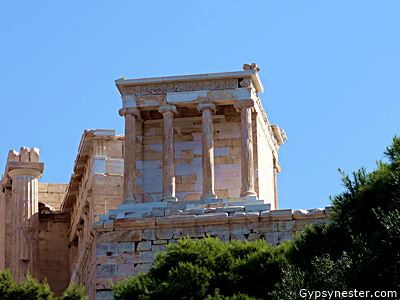 The Parthenon is only one of many tributes the Athenians dedicated to their patron goddess. Another is just a stone’s throw away, the Temple of Athena Nike. Built around the same time as its much larger neighbor, the version we see now is actually a reconstruction.
The Parthenon is only one of many tributes the Athenians dedicated to their patron goddess. Another is just a stone’s throw away, the Temple of Athena Nike. Built around the same time as its much larger neighbor, the version we see now is actually a reconstruction.
As with so many ancient monuments, more recent inhabitants often snatched the stones from the originals to make other structures, and like the Parthenon the remarkable statue of Athena in this temple is also long gone.
Luckily, one likeness of the goddess remains in the form of a relief from the parapet of the roof that is on display in the Acropolis Museum. Even luckier for us, that was to be our next stop.
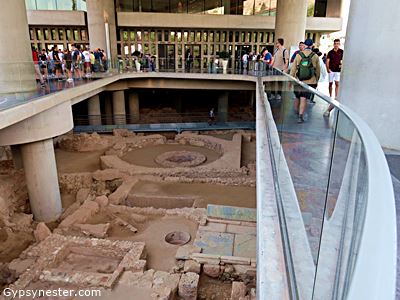 Originally the museum opened in 1874 and was up on the Acropolis, but as more and more artifacts were unearthed it became apparent that a bigger venue was needed. A location at the base of the famed rock outcrop was chosen and a completion for the design held but, as with almost everywhere in Athens, when construction began they discovered more ruins beneath the site.
Originally the museum opened in 1874 and was up on the Acropolis, but as more and more artifacts were unearthed it became apparent that a bigger venue was needed. A location at the base of the famed rock outcrop was chosen and a completion for the design held but, as with almost everywhere in Athens, when construction began they discovered more ruins beneath the site.
A unique, and we think very cool, solution was implemented. Openings were left in the entrance walkway and glass floors in the interior so visitors can look down at the ruins below. Windows were also set so that views of the Acropolis dominate the upper level that houses the original frieze from the temple.
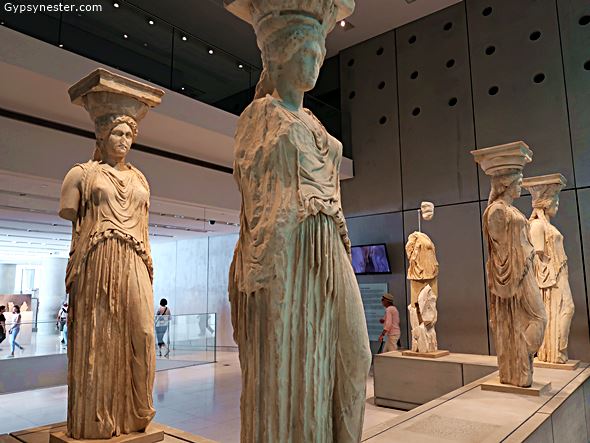 Another highlight of the museum, and one of the only exhibits that allows photographs inside, are the Caryatids of Erechtheum. Caryatids are female figures that serve as columns, and the Porch of the Maidens on the Erechtheum is perhaps the most classic example. Replicas support the porch on the temple up on the Acropolis, but the originals are safely tucked inside the museum.
Another highlight of the museum, and one of the only exhibits that allows photographs inside, are the Caryatids of Erechtheum. Caryatids are female figures that serve as columns, and the Porch of the Maidens on the Erechtheum is perhaps the most classic example. Replicas support the porch on the temple up on the Acropolis, but the originals are safely tucked inside the museum.
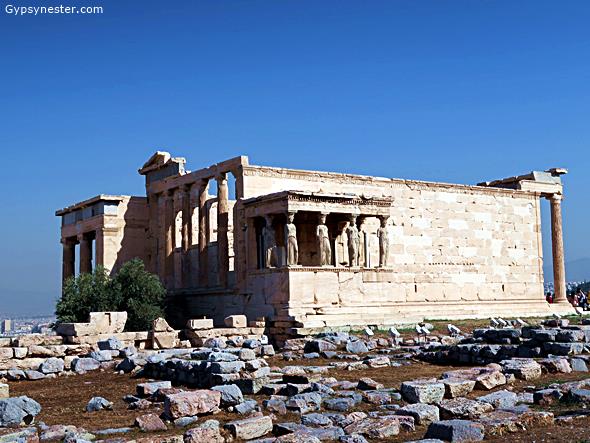 Even though the temple is small, it had importance much beyond its size because it marks the place where Poseidon’s spring flowed forth and Athena’s olive tree sprouted. It is also said to be the burial site of the mythic kings Cecrops, first king of Athens, and Erechtheus, who according to Homer’s Iliad was raised by Athena.
Even though the temple is small, it had importance much beyond its size because it marks the place where Poseidon’s spring flowed forth and Athena’s olive tree sprouted. It is also said to be the burial site of the mythic kings Cecrops, first king of Athens, and Erechtheus, who according to Homer’s Iliad was raised by Athena.
The fact that this recorded history goes back over three thousand years shows just how much this has been a dynamic capital city almost since civilization began. There is also much more to it than just the Acropolis, so we set out to see as much as we could in our limited time.
Our second day began bright and early at The Panathenaic Stadium. It is also known as Kallimarmaro, meaning beautiful marble, and we must say that it is quite a sight to see a stadium that holds up to 80,000 people made entirely of marble, the only one in the world.
This was the original Olympic Stadium from back when the games were called the Panathenaic Games centuries before Christ. It was completely restored for the 1896 resumption of the modern Olympics and also served in the 2004 games.
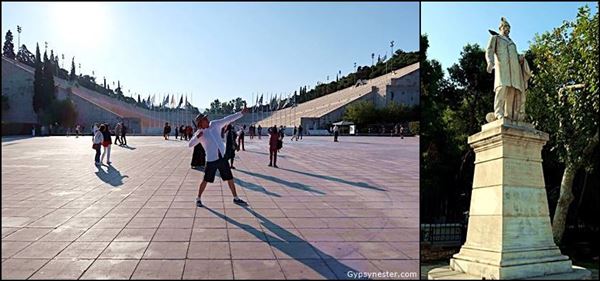
Once again our gifted guide came through with a fun fact (he is named after the god of revelry after all). The cost of refurbishing the stadium was so prohibitive that a common Greek saying was spawned, “Who’s going to pay for the marble?” The answer was a businessman named George Averoff, and the donation earned him a permanent place right outside the stadium, carved in yet more marble.
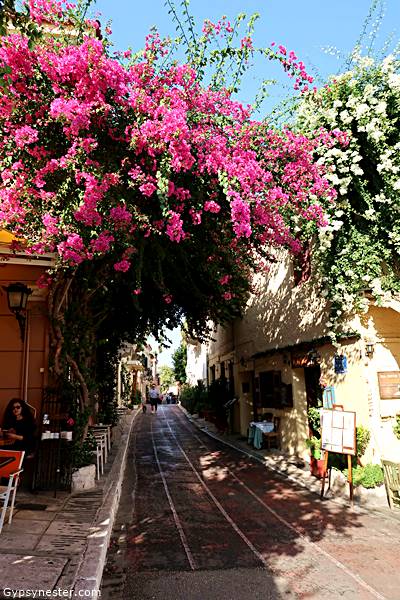
The rest of our final day in Athens was spent exploring the area around the base of the Acropolis, in the neighborhood known as the Plaka. This is the oldest part of the city, so everywhere we looked we encountered millennium on millennium of antiquity.
Originally this was the residential area of the ancient city and it is sometimes called the “Neighborhood of the Gods” since it sits in the shadow of the Acropolis. Now it is a tourist haven filled with shops, restaurants, bars, and still some ruins from long ago.
Most of those relics are in the Agoras, both Roman and Greek. These were the central public areas, much like the Forum in Rome, and fortunately have not been built over. We came to the Roman section first and were most taken by the fully intact Tower of the Winds.
 At first sight the forty foot high structure may not be overwhelming, but as we learned about its function we were duly impressed. This is the world’s first weather station. The tops of the eight sides each depict a direction of the wind carved in relief that a vane pointed to in the breeze.
At first sight the forty foot high structure may not be overwhelming, but as we learned about its function we were duly impressed. This is the world’s first weather station. The tops of the eight sides each depict a direction of the wind carved in relief that a vane pointed to in the breeze.
There were also sun dials on each wall and a water driven clock inside, so this could rightly be considered the world’s first clock tower.
From the Roman area we moved on to the Greek side, which predates it. Mostly we wanted a close up look at Temple of Hephaestus. We had seen it from afar while on top of the Acropolis and were bound and determined to get a better view.
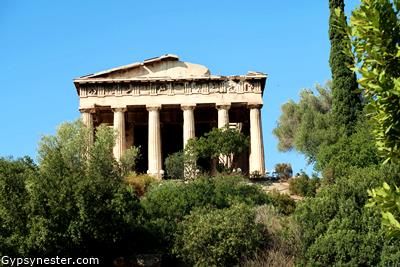 Looking very much like a miniature Parthenon, this is widely held as the best preserved temple from all of ancient Greece. It is likely that it survived so well because it had the good fortune to be converted to a church around the year 700 AD and continued in that capacity until 1833.
Looking very much like a miniature Parthenon, this is widely held as the best preserved temple from all of ancient Greece. It is likely that it survived so well because it had the good fortune to be converted to a church around the year 700 AD and continued in that capacity until 1833.
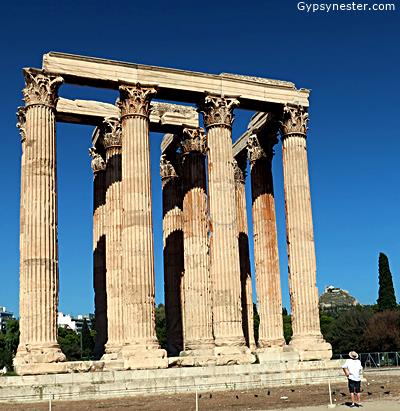 From the best preserved temple we made our way to one of the worst kept, the Temple of Olympian Zeus. Yet even though only sixteen columns remain, it is still remarkably impressive. When construction began in the 6th century BC it was to be the largest temple in Greece, but wasn’t finished until Rome had taken control.
From the best preserved temple we made our way to one of the worst kept, the Temple of Olympian Zeus. Yet even though only sixteen columns remain, it is still remarkably impressive. When construction began in the 6th century BC it was to be the largest temple in Greece, but wasn’t finished until Rome had taken control.
Emperor Hadrian managed to finish it over 600 years later, but after only a century a barbarian invasion ransacked the shrine. After that, much of the marble used in its construction was pilfered for building nearby houses and churches.
Guess we can’t blame them.
Who wouldn’t want to live in a home made from mythological marble?
David & Veronica, GypsyNester.com
See all of our previous adventures in Greece!
Thanks to Road Scholar for providing this lifelong learning adventure through the Greek Isles! As always, all opinions are our own.



I enjoyed your blog enough that I will read another. I enjoy travel myself and have contemplated getting into the blogosphere but I’m not sure if I want to commit the time. Anyway keep up your travels, I know I will. The only two things that restrict me are the size of my pocketbook and there are some places my wife won’t go.
Thanks, and Happy New Year! Safe and happy travels in 2020.